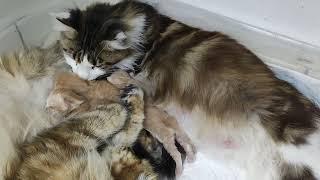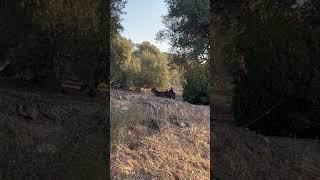Use coupon code "KITTENLIFE" to get 20% OFF The Best Cat Collars Available here :
https://www.bemixpets.com
( Use coupon code "KITTENLIFE" to get 20% OFF )
Maine Coon Facebook Page :
https://www.facebook.com/MaineCoon.org/
Maine Coon Facebook Group:
https://www.facebook.com/groups/mainecoonorg
===========================================================
In today's video, we are going to talk about interesting facts and myths surrounding The Manx Cat.
A Manx cat looks like your typical feline, that is until it turns around and you realize it’s missing a tail. Here are 10 facts about the unusual kitty, which hails from an island in the Irish Sea, and its adorably stubby posterior.
1. ITS MISSING TAIL STEMS FROM A GENETIC MUTATION.
Today, the Manx is an international show cat. However, its roots can be traced back to the humble Isle of Man. The remote island sits in the Irish Sea between Great Britain and Ireland. Hundreds of years ago, a genetic mutation caused one or more kitties on the Isle of Man to be born without a tail. Since the Isle of Man’s feline population is so small, generations of inbreeding caused the trait to become common among the local cats.
Naturally, the Manx is beloved on its native shores. It's been featured on currency, stamps, and company logos, and shops sell merchandise featuring the tail-less cat.
2. MANY CREATIVE LEGENDS SURROUND THE BREED.
Manx cat myths have been repeated time and time again throughout the ages. This feline has been the subject of myth and folklore for a very long time. Lets look at some of the myths surrounding this "rumpie" cat.
The oldest of the Manx folklore harks all the way back to the story of Noah and the ark. In that lore, the cat was the last to board the ark, and begged forgiveness, saying she would pay her way by mousing. Granted permission to board, she slowly sauntered aboard, as cats like to do, and wasn't quite fast enough. The hatch came down and severed her tail, creating the now tail-less Manx.
Others theorized that Manxes were “cabbits”, the hybrid offspring of a cat and a rabbit. Due to their long back legs, short tail, and rounded rump.
3. THE MANX WAS ONE OF THE WORLD’S FIRST SHOW CATS.
Animal lovers in England began showcasing Manx cats at some of the world’s first cat shows in the late 19th century. When the Cat Fanciers Association, the world's largest registry of pedigreed cats, was formed in 1906, the Manx was one of the founding breeds.
4. MANXES CAN GIVE BIRTH TO KITTENS WITH OR WITHOUT TAILS.
Manx cats carry one gene for a full tail, and one for taillessness. This means that two Manx cats can mate and produce a kitten that’s a typical long-tailed feline. Sadly, kittens that inherit the taillessness gene from both parents will likely die before birth. That’s why some people have nicknamed the Manx gene “the lethal gene.”
5. THEIR TAILS HAVE VARYING LENGTHS.
The Manx gene is an incomplete dominant gene, so kittens that inherit it can be born with full-length tails, stubby tails, or no tails at all, and all of these tail lengths can appear in a single litter.
Due to this variability, Manx cats are classified according to tail lengths. Completely tailless felines are called “rumpy,” whereas cats with short tail stumps that are often curved, knotted, or kinked are known as “stumpy,” and kitties with nearly normal-length tails are called “longy.” Only “rumpies,” or cats called “rumpy risers” that have a slight rise of bone where their tails would start, are eligible to compete in the championship classes in CFA cat shows.
https://www.bemixpets.com
( Use coupon code "KITTENLIFE" to get 20% OFF )
Maine Coon Facebook Page :
https://www.facebook.com/MaineCoon.org/
Maine Coon Facebook Group:
https://www.facebook.com/groups/mainecoonorg
===========================================================
In today's video, we are going to talk about interesting facts and myths surrounding The Manx Cat.
A Manx cat looks like your typical feline, that is until it turns around and you realize it’s missing a tail. Here are 10 facts about the unusual kitty, which hails from an island in the Irish Sea, and its adorably stubby posterior.
1. ITS MISSING TAIL STEMS FROM A GENETIC MUTATION.
Today, the Manx is an international show cat. However, its roots can be traced back to the humble Isle of Man. The remote island sits in the Irish Sea between Great Britain and Ireland. Hundreds of years ago, a genetic mutation caused one or more kitties on the Isle of Man to be born without a tail. Since the Isle of Man’s feline population is so small, generations of inbreeding caused the trait to become common among the local cats.
Naturally, the Manx is beloved on its native shores. It's been featured on currency, stamps, and company logos, and shops sell merchandise featuring the tail-less cat.
2. MANY CREATIVE LEGENDS SURROUND THE BREED.
Manx cat myths have been repeated time and time again throughout the ages. This feline has been the subject of myth and folklore for a very long time. Lets look at some of the myths surrounding this "rumpie" cat.
The oldest of the Manx folklore harks all the way back to the story of Noah and the ark. In that lore, the cat was the last to board the ark, and begged forgiveness, saying she would pay her way by mousing. Granted permission to board, she slowly sauntered aboard, as cats like to do, and wasn't quite fast enough. The hatch came down and severed her tail, creating the now tail-less Manx.
Others theorized that Manxes were “cabbits”, the hybrid offspring of a cat and a rabbit. Due to their long back legs, short tail, and rounded rump.
3. THE MANX WAS ONE OF THE WORLD’S FIRST SHOW CATS.
Animal lovers in England began showcasing Manx cats at some of the world’s first cat shows in the late 19th century. When the Cat Fanciers Association, the world's largest registry of pedigreed cats, was formed in 1906, the Manx was one of the founding breeds.
4. MANXES CAN GIVE BIRTH TO KITTENS WITH OR WITHOUT TAILS.
Manx cats carry one gene for a full tail, and one for taillessness. This means that two Manx cats can mate and produce a kitten that’s a typical long-tailed feline. Sadly, kittens that inherit the taillessness gene from both parents will likely die before birth. That’s why some people have nicknamed the Manx gene “the lethal gene.”
5. THEIR TAILS HAVE VARYING LENGTHS.
The Manx gene is an incomplete dominant gene, so kittens that inherit it can be born with full-length tails, stubby tails, or no tails at all, and all of these tail lengths can appear in a single litter.
Due to this variability, Manx cats are classified according to tail lengths. Completely tailless felines are called “rumpy,” whereas cats with short tail stumps that are often curved, knotted, or kinked are known as “stumpy,” and kitties with nearly normal-length tails are called “longy.” Only “rumpies,” or cats called “rumpy risers” that have a slight rise of bone where their tails would start, are eligible to compete in the championship classes in CFA cat shows.
- Catégories
- Chats de Race Manx
- Mots-clés
- Manx Cat facts, manx cat acts like dog, manx cat breed
















Commentaires